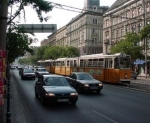 he Castle Quarter declared a UNESCO World Heritage Site, this is the core of the ancient town and has some of the most important historical monuments in Hungary.
he Castle Quarter declared a UNESCO World Heritage Site, this is the core of the ancient town and has some of the most important historical monuments in Hungary.
Underneath the streets is a labyrinth of caves used by German soldiers during World War two. Above ground is the magnificent Royal Palace with most of its wings now serving as museums. The palace also houses the National Szechenyi Library and the residence of the President of the Republic.
One of the most famous monuments in the the Castle Quarter is the 700 year old Matthias Church with its Gothic towers.
The Castle was the residence of Hungarian kings for ages. The fortification system and the palace were built in the 13th century following the Mongol invasion. It was destroyed and rebuilt many times, and being renewed from time to time symbolizes the country itself. Built on medieval foundations, the Renaissance structures were destroyed by the Turks. Later, the Baroque Palace burned down, then its reconstructed buildings were damaged during the War of Independence (1848). In the late 19 th century Miklos Ybl oversaw the reconstruction and enlargement of the Palace, which was completed in the neo-Baroque style by Alajos Hauszmann. We would recommend you to do a nice walk on the streets of the hill from Becsi Kapu until the Castle. It’s a good 20 minutes walk, but the old little streets and houses, and the other sights are worth to see as well. Other way is to walk through the Chain Bridge and then go up to the Castle with the funicular.
Directions: On the top of Castle Hill (Varhegy). Funicular from Clark Adam ter (Buda bridgehead of the Chain Bridge), bus #16 from Deak F. ter, bus VAR from Moszkva ter. No cars allowed.
